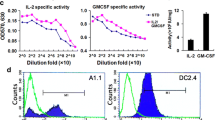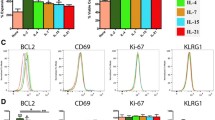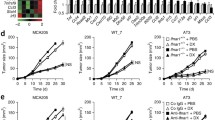Abstract
Fusokines are proteins formed by the fusion of two cytokines. They have greater bioavailability and therapeutic potential than individual cytokines or a combination of different cytokines. Interferon-gamma-inducible protein 10 (CXCL10) and lymphotactin (XCL1) are members of the chemotactic family of cytokines, which induce tumor regression by eliciting immune-system cell chemotaxis. We engineered a replication-deficient adenoviral system expressing CXCL10/XCL1 fusokine (Ad FIL) and assessed its chemotactic response in vitro and in vivo. The CXCL10/XCL1 fusokine elicited a greater chemotactic effect in IL-2 stimulated lymphocytes than individual or combined cytokines in vitro. CXCL10/XCL1 fusokine biological activity was demonstrated in vivo by intratumoral chemoattraction of CXCR3+ cells. Thus, this novel CXCL10/XCL1 fusokine may represent a potential tool for gene therapy treatment of cancer and other illnesses that require triggering immune-system cell recruitment.




Similar content being viewed by others
References
Cairns CM, Gordon JR, Li F et al (2001) Lymphotactin expression by engineered myeloma cells drives tumor regression: mediation by CD4+ and CD8+ T cells and neutrophils expressing XCR1 receptor. J Immunol Baltim Md 1950 167:57–65
Cheng W-F, Hung C-F, Chai C-Y et al (2001) Tumor-specific immunity and antiangiogenesis generated by a DNA vaccine encoding calreticulin linked to a tumor antigen. J Clin Invest 108:669–678
Dufour JH, Dziejman M, Liu MT et al (2002) IFN-γ-inducible protein 10 (IP-10; CXCL10)-deficient mice reveal a role for IP-10 in effector T cell generation and trafficking. J Immunol 168:3195–3204. doi:10.4049/jimmunol.168.7.3195
Gattinoni L, Powell DJ, Rosenberg SA, Restifo NP (2006) Adoptive immunotherapy for cancer: building on success. Nat Rev Immunol 6:383–393
Gomez-Gutierrez JG, Elpek KG, de Oca-Luna RM et al (2007) Vaccination with an adenoviral vector expressing calreticulin-human papillomavirus 16 E7 fusion protein eradicates E7 expressing established tumors in mice. Cancer Immunol Immunother CII 56:997–1007
Gooden MJM, de Bock GH, Leffers N et al (2011) The prognostic influence of tumour-infiltrating lymphocytes in cancer: a systematic review with meta-analysis. Br J Cancer 105:93–103
Huang H, Xiang J (2004) Synergistic effect of lymphotactin and interferon gamma-inducible protein-10 transgene expression in T-cell localization and adoptive T-cell therapy of tumors. Int J Cancer J Int Cancer 109:817–825
Källberg M, Wang H, Wang S et al (2012) Template-based protein structure modeling using the RaptorX web server. Nat Protoc 7:1511–1522
Lei Y, Takahama Y (2012) XCL1 and XCR1 in the immune system. Microbes Infect Inst Pasteur 14:262–267
Proudfoot AEI (2002) Chemokine receptors: multifaceted therapeutic targets. Nat Rev Immunol 2:106–115
Raman D, Baugher PJ, Thu YM, Richmond A (2007) Role of chemokines in tumor growth. Cancer Lett 256:137–165
Russell HV, Strother D, Mei Z et al (2007) Phase I trial of vaccination with autologous neuroblastoma tumor cells genetically modified to secrete IL-2 and lymphotactin. J Immunother Hagerstown Md 1997 30:227–233
Wang P, Yang X, Xu W et al (2010) Integrating individual functional moieties of CXCL10 and CXCL11 into a novel chimeric chemokine leads to synergistic antitumor effects: a strategy for chemokine-based multi-target-directed cancer therapy. Cancer Immunol Immunother CII 59:1715–1726
Wang X, Lu X-L, Zhao H-Y et al (2013) A novel recombinant protein of IP10-EGFRvIIIscFv and CD8(+) cytotoxic T lymphocytes synergistically inhibits the growth of implanted glioma in mice. Cancer Immunol Immunother CII 62:1261–1272
Wansom D, Light E, Thomas D et al (2012) Infiltrating lymphocytes and human papillomavirus-16 associated oropharynx cancer. Laryngoscope 122:121–127
Wennerberg E, Kremer V, Childs R, Lundqvist A (2014) CXCL10-induced migration of adoptively transferred human natural killer cells toward solid tumors causes regression of tumor growth in vivo. Cancer Immunol Immunother CII. doi:10.1007/s00262-014-1629-5
Williams P, Galipeau J (2011) GM-CSF–based fusion Cytokines as ligands for immune modulation. J Immunol 186:5527–5532
Yang X, Chu Y, Wang Y et al (2006) Targeted in vivo expression of IFN-gamma-inducible protein 10 induces specific antitumor activity. J Leukoc Biol 80:1434–1444
Zhang J, Zhou Z, Wang C et al (2011) Reduced tumorigenesis of EG7 after interleukin-10 gene transfer and enhanced efficacy in combination with intratumorally injection of adenovirus-mediated lymphotactin and the underlying mechanism. Cancer Immunol Immunother CII 60:559–573
Acknowledgments
This work was supported by Programa de Apoyo a la Investigación en Ciencia y Tecnología (PAICYT) No. SA381-10 from the UANL, and by ConsejoNacional de Ciencia y Tecnología (CONACYT) Grant No. CB-10-158509. YESL and JJPT were recipients of scholarships from CONACYT.
Conflict of interest
The authors declare that they have no conflict of interest.
Author information
Authors and Affiliations
Corresponding author
Rights and permissions
About this article
Cite this article
Sanchez-Lugo, Y.E., Perez-Trujillo, J.J., Gutierrez-Puente, Y. et al. CXCL10/XCL1 fusokine elicits in vitro and in vivo chemotaxis. Biotechnol Lett 37, 779–785 (2015). https://doi.org/10.1007/s10529-014-1746-4
Received:
Accepted:
Published:
Issue Date:
DOI: https://doi.org/10.1007/s10529-014-1746-4




